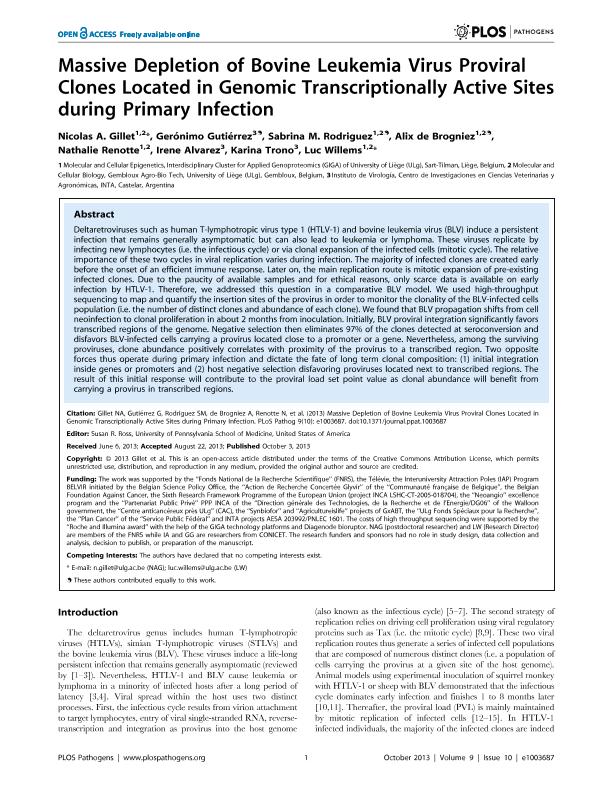Mostrar el registro sencillo del ítem
dc.contributor.author
Gillet, Nicolas A.
dc.contributor.author
Gutiérrez, Gerónimo

dc.contributor.author
Rodriguez, Sabrina M.
dc.contributor.author
de Brogniez, Alix
dc.contributor.author
Renotte, Nathelie
dc.contributor.author
Alvarez, Irene

dc.contributor.author
Trono, Karina Gabriela
dc.contributor.author
Willems, Luc
dc.date.available
2017-09-08T19:44:01Z
dc.date.issued
2013-10
dc.identifier.citation
Gillet, Nicolas A.; Gutiérrez, Gerónimo; Rodriguez, Sabrina M.; de Brogniez, Alix; Renotte, Nathelie; et al.; Massive depletion of bovine leukemia virus proviral clones located in genomic transcriptionally active sites during primary infection; Public Library of Science; Plos Pathogens; 9; 10; 10-2013; 1-13; e1003687
dc.identifier.issn
1553-7366
dc.identifier.uri
http://hdl.handle.net/11336/23871
dc.description.abstract
Deltaretroviruses such as human T-lymphotropic virus type 1 (HTLV-1) and bovine leukemia virus (BLV) induce a persistent infection that remains generally asymptomatic but can also lead to leukemia or lymphoma. These viruses replicate by infecting new lymphocytes (i.e. the infectious cycle) or via clonal expansion of the infected cells (mitotic cycle). The relative importance of these two cycles in viral replication varies during infection. The majority of infected clones are created early before the onset of an efficient immune response. Later on, the main replication route is mitotic expansion of pre-existing infected clones. Due to the paucity of available samples and for ethical reasons, only scarce data is available on early infection by HTLV-1. Therefore, we addressed this question in a comparative BLV model. We used high-throughput sequencing to map and quantify the insertion sites of the provirus in order to monitor the clonality of the BLV-infected cells population (i.e. the number of distinct clones and abundance of each clone). We found that BLV propagation shifts from cell neoinfection to clonal proliferation in about 2 months from inoculation. Initially, BLV proviral integration significantly favors transcribed regions of the genome. Negative selection then eliminates 97% of the clones detected at seroconversion and disfavors BLV-infected cells carrying a provirus located close to a promoter or a gene. Nevertheless, among the surviving proviruses, clone abundance positively correlates with proximity of the provirus to a transcribed region. Two opposite forces thus operate during primary infection and dictate the fate of long term clonal composition: (1) initial integration inside genes or promoters and (2) host negative selection disfavoring proviruses located next to transcribed regions. The result of this initial response will contribute to the proviral load set point value as clonal abundance will benefit from carrying a provirus in transcribed regions.
dc.format
application/pdf
dc.language.iso
eng
dc.publisher
Public Library of Science

dc.rights
info:eu-repo/semantics/openAccess
dc.rights.uri
https://creativecommons.org/licenses/by/2.5/ar/
dc.subject
Blv
dc.subject
Replication
dc.subject
Clones
dc.subject
Infection
dc.subject.classification
Bioquímica y Biología Molecular

dc.subject.classification
Ciencias Biológicas

dc.subject.classification
CIENCIAS NATURALES Y EXACTAS

dc.title
Massive depletion of bovine leukemia virus proviral clones located in genomic transcriptionally active sites during primary infection
dc.type
info:eu-repo/semantics/article
dc.type
info:ar-repo/semantics/artículo
dc.type
info:eu-repo/semantics/publishedVersion
dc.date.updated
2017-09-07T16:56:30Z
dc.journal.volume
9
dc.journal.number
10
dc.journal.pagination
1-13; e1003687
dc.journal.pais
Estados Unidos

dc.journal.ciudad
San Francisco
dc.description.fil
Fil: Gillet, Nicolas A.. Université de Liege; Bélgica
dc.description.fil
Fil: Gutiérrez, Gerónimo. Instituto Nacional de Tecnología Agropecuaria. Centro de Investigación en Ciencias Veterinarias y Agronómicas. Instituto de Virología; Argentina. Consejo Nacional de Investigaciones Científicas y Técnicas; Argentina
dc.description.fil
Fil: Rodriguez, Sabrina M.. Université de Liege; Bélgica
dc.description.fil
Fil: de Brogniez, Alix. Université de Liege; Bélgica
dc.description.fil
Fil: Renotte, Nathelie. Université de Liege; Bélgica
dc.description.fil
Fil: Alvarez, Irene. Instituto Nacional de Tecnología Agropecuaria. Centro de Investigación en Ciencias Veterinarias y Agronómicas. Instituto de Virología; Argentina. Consejo Nacional de Investigaciones Científicas y Técnicas; Argentina
dc.description.fil
Fil: Trono, Karina Gabriela. Instituto Nacional de Tecnología Agropecuaria. Centro de Investigación en Ciencias Veterinarias y Agronómicas. Instituto de Virología; Argentina. Consejo Nacional de Investigaciones Científicas y Técnicas; Argentina
dc.description.fil
Fil: Willems, Luc. Université de Liege; Bélgica
dc.journal.title
Plos Pathogens

dc.relation.alternativeid
info:eu-repo/semantics/altIdentifier/url/http://journals.plos.org/plospathogens/article?id=10.1371/journal.ppat.1003687
dc.relation.alternativeid
info:eu-repo/semantics/altIdentifier/doi/http://dx.doi.org/10.1371/journal.ppat.1003687
Archivos asociados
